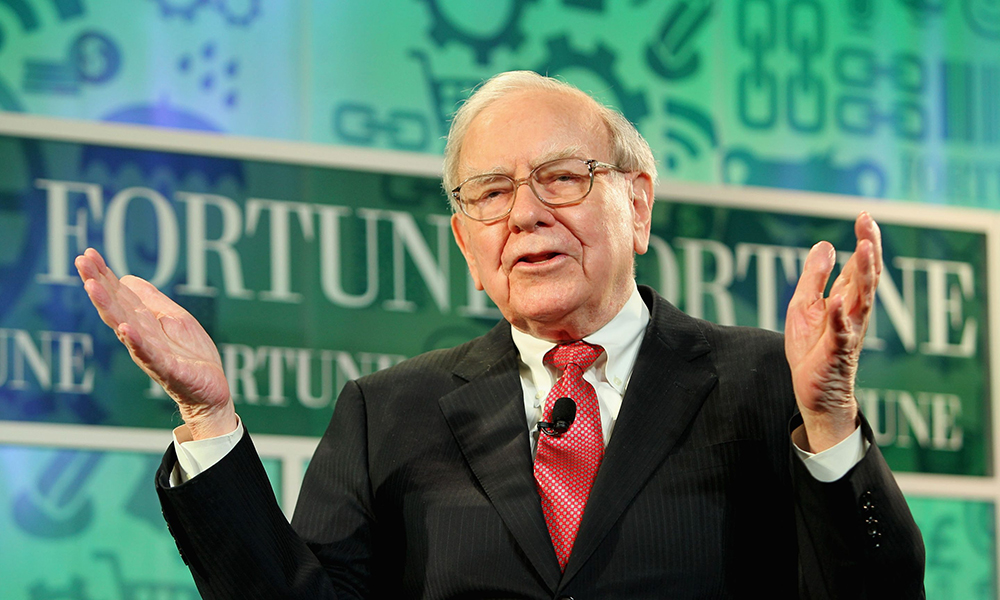
伯克希尔·哈撒韦公司(Berkshire Hathaway)股价周一下跌逾1.5%,原因是投资者得知这家著名企业集团第三季度净亏损近130亿美元。然而,尽管头条数字令人痛苦,但伯克希尔·哈撒韦公司旗下各类企业在第三季度的表现实际上优于其他公司。套用赛尔乔·莱昂内(Sergio Leone)的话来说,这里有好人、坏人和丑恶之人——但也许并没有看起来那么丑恶。
该公司股票投资组合价值缩水241亿美元,损失最为惨重,沃伦·巴菲特最青睐的苹果公司(Apple)损失超过200亿美元。如果你按照巴菲特喜欢的方式来评判他的业绩,那么这只是一个数字而已。
好的一面
伯克希尔·哈撒韦公司涉及业务广泛,包括保险公司、快餐公司,铁路公司和公用事业部门等。总体而言,该集团在第三季度的表现相当不错。该集团的营业利润数据衡量的是其旗下企业获得的利润,截至9月底,营业利润同比增长41%,达到108亿美元。伯克希尔·哈撒韦公司旗下最大的保险公司——政府雇员保险公司(Geico)是一大亮点,该公司连续第三个季度实现盈利(在前几年被竞争对手抢走市场份额后,该公司仍在继续扭亏为盈)。
由布莱恩·梅雷迪思(Brian Meredith)领导的瑞银(UBS)分析师在伯克希尔·哈撒韦公司财报发布后,维持了对伯克希尔·哈撒韦公司股票的“买入”评级,认为“政府雇员保险公司的业绩增长速度可能快于预期,从而推动预期上行。”瑞银团队在给客户的一份报告中写道,他们认为伯克希尔·哈撒韦公司的股价比该集团的真正“内在价值”低了大约12%。
他们补充说:“我们仍然认为,在宏观环境充满不确定性的情况下,伯克希尔·哈撒韦公司的股票是一只有吸引力的股票。”
截至9月底,伯克希尔·哈撒韦公司的现金储备也增至创纪录的1,572亿美元。由于利率上升,该公司在过去12个月里从现金储备中获得了大约51亿美元的利息收入。
坏的一面
伯克希尔·哈撒韦公司第三季度旗下企业投资组合中存在一些不可否认的痛点。巴菲特于2009年完成收购的伯灵顿北方圣达菲铁路公司(BNSF Railway)利润同比下降约15%,至12亿美元。该公司的货运量减少了近5%,导致货运收入较上年同期下降了12%。
伯克希尔·哈撒韦公司旗下公用事业部门第三季度的运营支出也飙升55%,达到37亿美元,原因是美国太平洋电力公司(PacifiCorp)因野火造成13亿美元损失。该公司是一家电力公司,为俄勒冈州、加州北部和华盛顿州东南部提供电力服务。伯克希尔·哈撒韦公司公用事业部门本季度整体营业利润仅增加4.98亿美元,而上年同期为16亿美元。
最后,伯克希尔·哈撒韦公司管理层警告说,经济环境仍然存在不确定性。高利率、地缘政治紧张局势和财政政策带来的影响尚未确定。事实上,该公司在一份声明中表示,“目前还无法合理估计这些事件对经济的长期影响”。
不那么糟糕的一面呢?
现在来谈谈(有点)糟糕的一面。
伯克希尔·哈撒韦公司第三季度的投资损失为241亿美元,这在很大程度上是由于其持有的苹果公司股票价值缩水逾200亿美元,而苹果公司在6月份的估值为1776亿美元。这家大型科技巨头的股价在第三季度下跌了11.7%,但此后又回升了3%以上。
不过,由于巨额投资损失,伯克希尔·哈撒韦公司本季度的“净亏损”总额为127.7亿美元,高于去年同期的28亿美元。
不过,巴菲特也会给这个"净亏损"数字加上引号。由于2018年美国通用会计准则(GAAP)的变化,伯克希尔·哈撒韦公司必须将其持有的证券价值按市值计价,并报告其未实现损益。这意味着,即使伯克希尔·哈撒韦公司没有出售所持股票并实际实现损益的计划,其收益也会根据所持股票的股价而波动。
以下是巴菲特对2019年美国通用会计准则变化的看法:
“根据新的美国通用会计准则……盈亏底线数字将完全是变幻莫测的。我确实认为这些盈亏底线数字……可能对我们的股东造成伤害,而且真的无济于事。”
巴菲特认为,投资者应该“关注我们所说的营业利润”,正如上文所述,这是衡量该集团旗下企业利润的指标。
伯克希尔·哈撒韦公司上周末发表了一份声明,重申了巴菲特的观点:“任何一个季度的投资收益/亏损通常都是没有意义的,而且它所提供的每股净收益(亏损)数字可能会对那些对会计规则知之甚少或一无所知的投资者产生极大的误导。”
该公司或许言之有理——即使市场不看好它的第三季度财报,但华尔街分析师似乎还是很看好该公司。
CFRA Research副总裁凯西·塞弗特(Cathy Seifert)周一维持对伯克希尔·哈撒韦公司B类股票的"买入"评级,并将其12个月目标价上调10美元至每股405美元。
塞弗特表示,不断增长的营业收入、保险费、“利息和股息收入激增70%”将帮助伯克希尔·哈撒韦公司在未来取得更好的业绩。她在给客户的报告中写道:“我们认为,强劲的顶线增长和利润率的提高将成为该公司股价的催化剂。”(财富中文网)
译者:中慧言-王芳
伯克希尔·哈撒韦公司(Berkshire Hathaway)股价周一下跌逾1.5%,原因是投资者得知这家著名企业集团第三季度净亏损近130亿美元。然而,尽管头条数字令人痛苦,但伯克希尔·哈撒韦公司旗下各类企业在第三季度的表现实际上优于其他公司。套用赛尔乔·莱昂内(Sergio Leone)的话来说,这里有好人、坏人和丑恶之人——但也许并没有看起来那么丑恶。
该公司股票投资组合价值缩水241亿美元,损失最为惨重,沃伦·巴菲特最青睐的苹果公司(Apple)损失超过200亿美元。如果你按照巴菲特喜欢的方式来评判他的业绩,那么这只是一个数字而已。
好的一面
伯克希尔·哈撒韦公司涉及业务广泛,包括保险公司、快餐公司,铁路公司和公用事业部门等。总体而言,该集团在第三季度的表现相当不错。该集团的营业利润数据衡量的是其旗下企业获得的利润,截至9月底,营业利润同比增长41%,达到108亿美元。伯克希尔·哈撒韦公司旗下最大的保险公司——政府雇员保险公司(Geico)是一大亮点,该公司连续第三个季度实现盈利(在前几年被竞争对手抢走市场份额后,该公司仍在继续扭亏为盈)。
由布莱恩·梅雷迪思(Brian Meredith)领导的瑞银(UBS)分析师在伯克希尔·哈撒韦公司财报发布后,维持了对伯克希尔·哈撒韦公司股票的“买入”评级,认为“政府雇员保险公司的业绩增长速度可能快于预期,从而推动预期上行。”瑞银团队在给客户的一份报告中写道,他们认为伯克希尔·哈撒韦公司的股价比该集团的真正“内在价值”低了大约12%。
他们补充说:“我们仍然认为,在宏观环境充满不确定性的情况下,伯克希尔·哈撒韦公司的股票是一只有吸引力的股票。”
截至9月底,伯克希尔·哈撒韦公司的现金储备也增至创纪录的1,572亿美元。由于利率上升,该公司在过去12个月里从现金储备中获得了大约51亿美元的利息收入。
坏的一面
伯克希尔·哈撒韦公司第三季度旗下企业投资组合中存在一些不可否认的痛点。巴菲特于2009年完成收购的伯灵顿北方圣达菲铁路公司(BNSF Railway)利润同比下降约15%,至12亿美元。该公司的货运量减少了近5%,导致货运收入较上年同期下降了12%。
伯克希尔·哈撒韦公司旗下公用事业部门第三季度的运营支出也飙升55%,达到37亿美元,原因是美国太平洋电力公司(PacifiCorp)因野火造成13亿美元损失。该公司是一家电力公司,为俄勒冈州、加州北部和华盛顿州东南部提供电力服务。伯克希尔·哈撒韦公司公用事业部门本季度整体营业利润仅增加4.98亿美元,而上年同期为16亿美元。
最后,伯克希尔·哈撒韦公司管理层警告说,经济环境仍然存在不确定性。高利率、地缘政治紧张局势和财政政策带来的影响尚未确定。事实上,该公司在一份声明中表示,“目前还无法合理估计这些事件对经济的长期影响”。
不那么糟糕的一面呢?
现在来谈谈(有点)糟糕的一面。
伯克希尔·哈撒韦公司第三季度的投资损失为241亿美元,这在很大程度上是由于其持有的苹果公司股票价值缩水逾200亿美元,而苹果公司在6月份的估值为1776亿美元。这家大型科技巨头的股价在第三季度下跌了11.7%,但此后又回升了3%以上。
不过,由于巨额投资损失,伯克希尔·哈撒韦公司本季度的“净亏损”总额为127.7亿美元,高于去年同期的28亿美元。
不过,巴菲特也会给这个"净亏损"数字加上引号。由于2018年美国通用会计准则(GAAP)的变化,伯克希尔·哈撒韦公司必须将其持有的证券价值按市值计价,并报告其未实现损益。这意味着,即使伯克希尔·哈撒韦公司没有出售所持股票并实际实现损益的计划,其收益也会根据所持股票的股价而波动。
以下是巴菲特对2019年美国通用会计准则变化的看法:
“根据新的美国通用会计准则……盈亏底线数字将完全是变幻莫测的。我确实认为这些盈亏底线数字……可能对我们的股东造成伤害,而且真的无济于事。”
巴菲特认为,投资者应该“关注我们所说的营业利润”,正如上文所述,这是衡量该集团旗下企业利润的指标。
伯克希尔·哈撒韦公司上周末发表了一份声明,重申了巴菲特的观点:“任何一个季度的投资收益/亏损通常都是没有意义的,而且它所提供的每股净收益(亏损)数字可能会对那些对会计规则知之甚少或一无所知的投资者产生极大的误导。”
该公司或许言之有理——即使市场不看好它的第三季度财报,但华尔街分析师似乎还是很看好该公司。
CFRA Research副总裁凯西·塞弗特(Cathy Seifert)周一维持对伯克希尔·哈撒韦公司B类股票的"买入"评级,并将其12个月目标价上调10美元至每股405美元。
塞弗特表示,不断增长的营业收入、保险费、“利息和股息收入激增70%”将帮助伯克希尔·哈撒韦公司在未来取得更好的业绩。她在给客户的报告中写道:“我们认为,强劲的顶线增长和利润率的提高将成为该公司股价的催化剂。”(财富中文网)
译者:中慧言-王芳
Berkshire Hathaway stock sank more than 1.5% on Monday as investors digested the famous conglomerate reporting a nearly $13 billion net loss for the third quarter. Despite the painful headline number, however, the diverse array of businesses Berkshire owns actually outperformed in the third quarter. To paraphrase Sergio Leone, it was a case of the good, the bad, and the ugly—but maybe not as ugly as it looks.
A $24.1 billion drop in the value of the firm’s stock portfolio did the most damage, with Warren Buffett’s favorite name, Apple, losing more than $20 billion on its own. If you judge Buffett’s performance the way he prefers to judge things, that is just a number, though.
The good
Berkshire owns a wide range of businesses, including insurance and fast-food companies as well railroads, utilities, and more. And, as a whole, the group did quite well in the third quarter. The conglomerate’s operating earnings figure measures the profits it makes from its owned businesses, and it surged 41% year-over-year to $10.8 billion by the end of September. Geico, the largest of Berkshire’s insurance holdings, was a particular bright spot, reporting its third straight profitable quarter as its turnaround continues after losing market share to competitors in previous years.
UBS analysts led by Brian Meredith maintained their “buy” rating for Berkshire shares after earnings, arguing “GEICO’s results can improve quicker than expected, driving upside to estimates.” The UBS team wrote in a note to clients that they believe Berkshire’s stock trades at a roughly 12% discount to the conglomerate’s true “intrinsic value.”
“We continue to believe BRK’s shares are an attractive stock in an uncertain macro environment,” they added.
Berkshire also increased its cash pile to a record $157.2 billion by the end of September. And the firm has now earned roughly $5.1 billion in interest income from its cash over the past 12 months due to rising interest rates.
The bad
There were some undeniable sore spots in Berkshire’s portfolio of owned businesses in the third quarter. BNSF Railway, which Buffett finished acquiring in 2009, saw its profits drop roughly 15% year-over-year to $1.2 billion. BNSF hauled almost 5% fewer shipments, leading freight revenues to drop 12% from a year ago.
Berkshire’s utility unit also saw its operating expenses soar 55% in the third quarter to $3.7 billion due to a $1.3 billion wildfire related loss at PacifiCorp, an electric utility that serves Oregon, northern California, and southeastern Washington. Overall the utility segment of Berkshire added just $498 million in operating profits in the quarter, compared to $1.6 billion in the same period a year ago.
And finally, Berkshire’s management warned that the economic environment remains uncertain. The impact of higher interest rates, geopolitical tensions, and fiscal policies has yet to be determined. In fact, “the economic effects from these events over longer terms cannot be reasonably estimated at this time,” the company said in a statement.
And the not so ugly?
Now to the (somewhat) ugly.
Berkshire had an investment loss of $24.1 billion in the third quarter due in large part to the more than $20 billion decline in the value of its Apple stake, which was valued at $177.6 billion in June. Shares of the big tech giant sank 11.7% in the third quarter, but have since recovered more than 3%.
Still, due to the big investment loss, Berkshire’s “net loss” for the quarter totaled $12.77 billion, up from $2.8 billion in the same period a year ago.
But Buffett would put that “net loss” figure in quotes, too. Due to a change in the Generally Accepted Accounting Principles (GAAP) in 2018, Berkshire must mark the value of its securities holdings to market, and report both unrealized gains and losses. This means that Berkshire’s earnings can fluctuate based on the stock prices of its holdings, even if it has no plans to sell them and actually realize those gains or losses.
Here’s what Buffett had to say about the change to GAAP in 2019:
With “the new GAAP rules … The bottom line figures are going to be totally capricious. I really regard these bottom line figures … as potentially being harmful to our shareholders and really not being helpful.”
Buffett argued investors should “focus on what we call our operating earnings,” which, as described above, are a measure of the profits of the conglomerate’s owned businesses.
Berkshire put out a statement reiterating Buffett’s message over the weekend: “The amount of investment gains/losses in any given quarter is usually meaningless and delivers figures for net earnings (losses) per share that can be extremely misleading to investors who have little or no knowledge of accounting rules,” it reads.
The company might have a point—even if the market didn’t like its third quarter earnings report, Wall Street analysts certainly seemed to.
Cathy Seifert, vice president at CFRA Research, maintained her “buy” rating on Berkshire Hathaway Class B shares on Monday and lifted her 12-month price target $10 to $405 per share.
Seifert said rising operating revenues, insurance premiums, a “70% surge in interest and dividend income” will help Berkshire outperform moving forward. “Strong top-line growth and improved margins will provide the shares with a catalyst, in our view,” she wrote in a note to clients.






